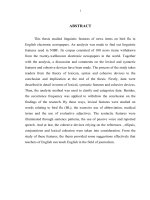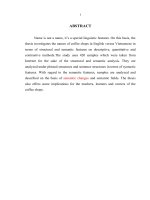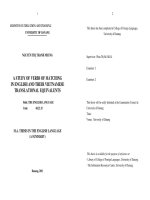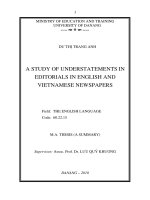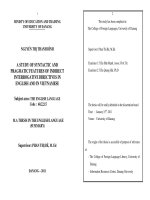operating performance in private equity buyouts - a study of buyouts in sweden between 2001-2008
Bạn đang xem bản rút gọn của tài liệu. Xem và tải ngay bản đầy đủ của tài liệu tại đây (381.76 KB, 65 trang )
Department of Business Administration May 2011
Bachelor Thesis
Operating Performance in Private Equity
Buyouts
- A study of buyouts in Sweden between 2001-2008
Authors: Alexander Molander, Emil Nerme and Tobias Nordblom
Tutor: Tore Eriksson
Sammanfattning
Titel:
Seminariedatum:
Ämne/kurs:
Författare:
Handledare:
Fem nyckelbegrepp:
Syfte:
Operating Performance in Private Equity Buyouts
2011-06-03
FEKK01, Examensarbete kandidatnivå, 15 högskolepoäng
Alexander Molander, Emil Nerme och Tobias Nordblom
Tore Eriksson
Private equity, buyout, operating performance, agency cost,
working capital management
Denna uppsats syftar till att undersöka operationella förbättringar i
private equity buyouts från tre perspektiv; lönsamhet,
arbetskapitalhantering och anställda
Metod:
Teoretiska perspektiv:
Empiri:
Slutsats:
En studie med kvantitativ och deduktiv metod
Agency cost, working capital management och wealth transfer
Detta examensarbete analyserar förändringar i operativa resultat
för ett urval av 110 svenska buyouts från 2001 till 2008. Uppsats
analyserar förändringar i lönsamhet, rörelsekapitalet och anställda.
I de fall där vi har signifikanta skillnader mellan de två
urvalsgrupper har regressioner gjorts för att testa sambandet
mellan storlek på företaget och operativa förbättrningar.
Våra resultat påvisar signifikanta industri-justerade förbättringar
för avkastning på operativt kapital och för leverantörsskulder. För
resterande variabler hittades inga signifikanta resultat. För de
variabler med signifkant skillnad har en regressioner gjorts, där
endast payables visade sig signifikant. Resultatet påvisar att värde
fortfarande skapas genom private equity buyouts med hänsyn till
lönsamhet och working capital management, medans resultaten för
employee management påvisar att värde inte skapas på bekostnad
av de anställda.
Abstract
Title:
Seminar date:
Course:
Authors:
Tutor:
Key terms:
Purpose:
Methodology:
Operating Performance in Private Equity Buyouts
2011-06-03
FEKK01, Bachelor thesis, 15 ECTS credits
Alexander Molander, Emil Nerme and Tobias Nordblom
Tore Eriksson
Private equity, buyout, operating performance, agency cost,
working capital management
The purpose of this thesis is to study value creation in private
equity buyouts in Sweden from operational improvements in three
areas; profitability, working capital management and employee
management
A study using quantitative and deductive methods
Theoretical perspectives: Agency theory, working capital management and wealth transfer
Empirical foundation:
Conclusions:
This thesis analyses changes in operating performance for a
sample of 110 Swedish buyouts from 2001 through 2008 based on
measures of profitability, working capital management and
employee management. Furthermore, regression models have been
made in cases where we have significant differences between our
sample and peer groups to test the correlation between company
size and operational performance.
Our results report only significant industry-adjusted improvements
in return on operating capital and for payables. For the rest of our
results no conclusive results were found. For the regression, only
payables were found significant. Concluding, the results document
that value is created in private equity buyouts with regards to
profitability and working capital management while results for
employee management show that wealth transfer is not found to be
a source of value creation.
Table of Contents
1
Introduction 6
1.1
1.2
1.3
1.4
1.5
1.6
Background 6
Problem discussion 7
Purpose 8
Delimitations 8
Audience 9
Outline 9
2
Theory 10
2.1 Agency theory 10
2.1.1
2.1.2
2.1.3
2.1.4
Improved incentives alignment 10
Improved monitoring and control 10
Reduction of agency cost of free cash flow 11
Agency cost hypotheses 11
2.2 Working capital management 12
2.2.1 Working capital management hypotheses 12
2.3 Wealth transfer 13
2.3.1 Wealth transfer hypotheses 13
2.4 Statistical and econometric theory 14
2.4.1
2.4.2
2.4.3
2.4.4
2.4.5
2.4.6
2.4.7
2.4.8
2.4.9
Student’s t-test 14
Wilcoxon signed rank test 14
The classical linear regression model 14
Least squares principle 15
Ordinary least squares 16
RESET-test 16
White’s general test of heteroscedasticity 16
Cross sectional data 16
Central limit theory 17
3
4
Previous research of relevance for this study 18
Methodology 20
4.1
4.2
4.3
Deductive method 20
Quantitative method 20
Validity, reliability and replicability 20
4.4 Operating performance variables 21
4.4
.1
4.4
.2
4.4
.3
Profitability
22
Working capital
management 22
Employee
management 23
4.
5
4.
6
4.
7
Calculating variables 24
Time period 25
Data 25
4.7
.1
4.7
.2
Sample
group 25
Peer
group 26
4.
8
Statistical tests 27
5
Empirical
findings 29
5.
1
5.
2
5.
3
Profitability 29
Working capital management 30
Employee management 31
6
Analysis
33
6.
1
6.
2
6.
3
6.
4
Profitability 33
Working capital management 34
Employee management 35
General analysis 35
7
8
9
Conclusions
37
References
39
Appendix
43
9.1
9.2
9.3
Appendix
1
43
Appendix
2
46
Appendix
3
47
1 Introduction
In 2010 the worldwide deal value of the private equity buyout market summed up to 180
billion USD, down from its record values before the financial crisis of 698 billion USD in
2006 and 665 billion USD in 2007 (MacArthur et al. 2011). In the aftermath of the
financial
crisis, private equity fundraising activity has also dramatically declined from 666 billion
dollars in 2008 to 228 billion dollars in 2010. Furthermore, there has been a trend of an
increasing number of smaller buyouts relative the total number of buyouts with buyouts
valued above 5 billion dollars almost vanishing (MacArthur et al. 2011). For the Swedish
market the development has followed similar trends, explained in the following
quotation:
“From my perspective I see three main trends affecting the private equity market in
Sweden
•
•
•
2008 and 2009 was characterized by a significant decrease in the number of buyouts
Swedish private equity funds has still large amounts of committed capital that needs
to
be invested in the coming years
The buyout size has decreased because of lack of bank financing as well as a
skepticism amongst Limited Partners to mega buyouts with regards to returns
Due to committed capital and the decreased buyout size has asset prices increased
significantly recently. This effect has further been accelerated because of the strong
business
cycle in Sweden relative Europe and Nordic attracting interest not from only Swedish
private
equity firms but also from international private equity firms” (Kühl, J. J., pers. medd.,
2011)
With the recent trends in both the global and Swedish private equity market in mind it is
reasonable to question if a explanation can be found by studying value creation in private
equity buyouts and if value creation depend on investment size
The history of the private equity industry began already in the middle of the last century
in the
United States and United Kingdom but with few formal private equity investors, instead
the
mar
ket
was
do
min
ated
by
indi
vid
uals
,
fou
ndat
ions
,
uni
vers
ities
and
char
ities
well
into
the
197
0s
(Gr
abe
nwa
rter
&
Wei
dig
200
5).
Ho
wev
er,
afte
r
regulatory changes and easily available
financing through the junk bond market the private equity buyout market boomed in the
late
1980s, peaking in 1988 with KKR’s 25 billion acquisition of RJR Nabisco. Following the
fall
of the junk bond market the deal value of buyouts dropped in the early 1990s to peak again in
the late 1990s with the dot-com boom (Kaplan & Strömberg 2009). Transaction values once
again dropped in the early 2000s with the business cycle to again increase dramatically up to
the financial crisis in 2008 (MacArthur et al. 2011). During the history of private equity the
type of buyouts has changed from the large public-to-private transactions in the late 1980s to
a dominance of middle market buyouts of non-listed firms or carve-outs from large companies
in the 1990s and early 2000s, making up 80 percent of the transaction value. Also, a new
phenomenon of secondary buyouts, private-equity-to-private-equity transactions, emerged
during the early 2000s. Up until the financial crisis the large public-to-private buyouts
returned, tripling in size between 2001 and 2006 (Kaplan & Strömberg 2009). After the
financials crisis the total buyout deal value and size has once again dropped, raising questions
about value creation in private equity buyouts and if the relatively larger fraction of smaller
buyouts is a new standard or due to illiquidity in the credit market (MacArthur et al. 2011).
From a geographical perspective private equity buyouts have developed from being a United
States, Canada and to some extent United Kingdom phenomenon in the 1980s to a global
phenomenon in more recent times. However, in regard to transaction value, North America
and Europe still make up over 80 percent of total buyout value (MacArthur et al. 2011). The
first Swedish private equity firm Procuritas was founded in 1986 followed by Industri Kapital
and Nordic Capital in 1989 (Lundgren & Norberg 2006). Since then the number of firms in
the Swedish private equity market has grown substantially and today there are more than 60
private equity firms active in Sweden (SVCA Member Database). From a European
perspective is the Swedish private equity market well developed with private equity buyouts
representing 0.43 percent of GDP in 2009, the second highest country percentage after United
Kingdom and well above the European average of 0.19 percent of GDP (EVCA Private
Equity Investment as Percentage of GDP in 2009).
Since the surge of private equity buyouts in late 1980s questions have been raised if private
equity creates value. From a theoretical perspective operational value in private equity
buyouts can be created based on three theories; reduction of agency costs, working capital
management and wealth transfer (Jensen 1986a). Research on private equity value creation
started already in the late 1980s where Kaplan published one of the most influential papers on
private equity buyouts and operational value creation. The study found that private equity
buyouts lead to increases in operating income before depreciation, increases in net cash flow
and decreases in capital expenditures compared to industry changes (Kaplan 1989). After
Kaplan (1989) there has been a large number of research papers studying operating
performance in private equity buyouts from three perspectives; profitability, working capital
management and employee management. However, the results have been somewhat
inconclusive. Furthermore, there have been studies focusing on the Swedish market where
e.g. Lundgren and Norberg (2006) found no statistically significant differences for private
equity buyouts adjusted for industry changes while Grubb and Jonsson (2007) found a
significant positive industry-adjusted change in profitability but no significant results for
employee management. The number of Swedish private equity buyouts studied in previous
research has ranged from 21 to 73 making this study, to our knowledge, the most extensive
study on private equity buyouts in Sweden with 110 buyouts included in the sample.
Moreover, studying the relationship between operating performance and company size is a
novel approach to private equity, aimed to provide more understanding of the recent trend of
smaller private equity buyouts (MacArthur et al. 2011). Selecting a shorter and more recent
time period compared to previous research additionally increases the studies ability to explain
and test recent trends in private equity buyouts.
The purpose of this thesis is to study value creation in private equity buyouts in Sweden from
operating performance in three areas; profitability, working capital management and
employee management. The results are a contribution to previous research on operating
performance in private equity buyouts and can be used by private equity investors or to gain
more knowledge on how value is created in private equity buyouts.
The study is limited to private equity buyouts during the period 2001-2008 in Sweden. The
buyouts are tested from entry to exit, or if no exit has been made from entry to 2009 as no
annual reports were available after 2009 when conducting this study. Buyouts with private
equity ownership of less than two years are excluded from the sample. Furthermore are
buyouts from venture capital and other non private equity companies excluded. Variables are
tested as the first difference for year-on-year changes. Entry is defined as the accounting year
for which the private equity firm acquires the company and thus the first year of private
equity ownership. Exit year is defined as the accounting year during which the private equity
firm divest the company and is also the last year of observation. No consideration is made
regarding when during the accounting year entry or exit is made. All information used is
publicly available from the respective company annual reports.
The thesis assumes the reader is familiar with basic understanding of finance, statistics and
econometrics. More detailed descriptions of the theoretical framework can found by reading
reference literature. The results are relevant for both academic and professional purposes.
This thesis is constructed as follows. The next section presents the theoretical framework
used, where both finance and econometrics theories are presented. The third section outlines
previous research and the fourth section presents the methodology. Empirical findings are
presented in the fifth section followed by analysis in the sixth section. The last and seventh
section is conclusions, summarizing the contribution of this thesis.
2 Theory
The following section aims to give the reader a brief introduction and explanation of the
theories used. More detailed descriptions of the theoretical framework can found by
reading
reference literature.
The agency theory looks at organizational conflicts, risk and incentives. In other words,
the
potential conflicts of interest between parties with different interests in the same asset. A
well-
known situation is the conflict between management and shareholders (Eisenhardt 1989).
!""
Traditionally in buyouts the private equity firm’s management acquires a substantial
equity
stake in the target company. This action eliminates the potential misalignment between
the
management and the shareholders. Moreover, a substantial equity stake in the target
company
encourages management to focus on value maximizing procedures leading to better
investment and operational decisions (Kaplan 1989). Furthermore, with management
owning
a substantial stake in the company this makes the personal cost of inefficiency to increase
which further leads to reduced incentives for management to shirk (DeAngelo 1984).In
addition, as target companies equity becomes illiquid with private equity ownership,
incentives for short-term manipulation by the management is reduced (Kaplan &
Strömberg
2009).
Management owning a substantial equity stake in the portfolio company can also induce
negative effects for the firm. Positive net present value investment opportunities might be
avoided as they are considered too risky by management due to risk aversion as their own
wealth is at stake (Holthausen & Larcker 1996).
!"
Cott
er
and
Pec
k
(20
01),
arg
ue
that
shar
ehol
ders
’ of
buy
out
firm
s
hav
e
grea
ter
ince
ntiv
es
to
acti
vely
mo
nito
r
the
com
pan
y.
Thi
s
foll
ows
as
priv
ate equity owned companies have less
dispersed ownership than public companies. The illiquid equity in companies owned by
private equity firms further strengthens shareholders incentives to monitor the company
as
there is an illiquid secondary market leading to no easy exit opportunities. Other benefits
following a buyout are the increased control of the company. As private equity firms
control
their companies they are also in control of the management as well as the board of directors,
the possible misalignment conflict can thereby be solved more easily than in public
companies (Jensen & Murphy 1989). According to Acharya et al. (2009), the board of
directors of private equity owned companies tend to be more active and meet more frequently
than for publicly traded companies. The active ownership could partially be explanatory for
the high return of private equity funds.
#$$$ %&
The increased debt level following a leveraged buyout contributes to reduce the agency cost
that could arise when management decide to make investments with lower returns than cost of
capital (Jensen 1986a). Therefore, one of the primary contributions of high debts levels is that
management is forced to allocate future cash flow to debt payments and thereby reducing
opportunities of wasteful and inefficient spending. The increased debt level also motivates
management to run the company more efficiently in order to avoid default, which is costly for
managers with respect to loss of control and a damaged reputation (Jensen 1986b).
Consequently, the downside of default might induce management to work harder and more
efficiently.
The increased level of debt could also lead to negative effects for the target company. High
debt levels leads to the company being more sensitive to unforeseen events such as market
shocks which auxiliary contributes to an increased probability of default (Singh 1990). The
greater exposure to financial stress comes as a result from the high leverage and that the
company could not be able to endure the unanticipated shocks as large interest payments
reduce the company’s financial flexibility (Rappaport 1990). Moreover, pursuant to Palepu
(1990), the augmented vulnerability of financial stress can possibly make a company more
short-term oriented and therefore disregard positive net present value investment
opportunities, what Berk and DeMarzo (2007), refers to as a debt overhang.
Based on the agency theory the following hypotheses related to profitability are tested:
•
•
Hypothesis 1: Target companies experience no post-buyout change in EBITDA margin
relative to peers
Hypothesis 2: Target companies experience no post-buyout change in ROA relative to
peers
•
Hypothesis 3: Target companies experience no post-buyout change in ROOC relative
to peers
According to the agency theory reduction of agency cost leads to firms being run more
efficiently as management focus on value maximizing; hence EBITDA margin is
expected to
increase. The theory suggests that improved incentives, monitoring and control lead to
improved profitability therefore ROA is anticipated to increase. Moreover, ROOC is
likely to
increase as reduction of agency cost of free cash flow includes reduction of wasteful
spending. If any of the statistical hypotheses prove to be significant, a regression will
be made
with profitability operating performance variable as dependant variable and company
size,
measured as revenue, as independent variable. The reason is to test if operational
improvements are larger in smaller companies and can explain the recent trend of
smaller
buyouts.
'
Following a buyout it is common for private equity firms to induce operational
restructuring
for their target companies. Operational and capital restructuring enables a more
efficient use
of the companies’ resources (Muscarella & Vetsuypens 1990). An imperative step for
increasing the overall efficiency following a buyout is by initiating cost reduction
programs
and decreasing the overhead costs (Easterwood et al. 1989). Common ways of
enhancing the
operational efficiency is by increasing capital productivity or reducing capital
requirements or
a combination of the two (Berg & Gottschalg 2004). According to Singh (1990),
private
equity held companies have lower levels of inventory and accounts receivable
compared to
industry peers. These improvements are a result of a more efficient inventory
management as
well as better management of accounts receivable and lowered amounts of working
capital
.
Additi
onally,
a
comm
on
feature
for
post-
buyout
compa
nies is
the
reducti
on of
organi
zationa
l
compl
exity
and
thus
strengt
hened
focus
on
compa
ny
core
busine
ss,
which
further
fortifie
s the
connec
tion
betwee
n
strategic refocusing and buyouts.
'
Based on the above presented theory the following hypotheses are tested:
•
Hypothesis 4: Target companies experience no post-buyout change in net working
capital divided by sales relative to peers
•
•
Hypothesis 5: Target companies experience no post-buyout change in accounts
receivable divided by sales relative to peers
Hypothesis 6: Target companies experience no post-buyout change in accounts
payable divided by sales relative to peers
Theories conclude that target companies often experience post-buyout restructuring
and a
more efficient use of company resources by e.g. increased capital productivity.
NWC/Sales
are therefore likely to decrease. In addition, theory implies that buyout companies
experience
improved accounts receivable and working capital management, therefore accounts
receivable/sales is expected to decrease and accounts payable/sales is expected to
increase. If
any of the statistical hypotheses prove to be significant, a regression will be made with
working capital management operating performance variable as dependant variable
and
company size, measured as revenue, as independent variable. This will be done in
order to test
if operational improvements are larger in smaller companies and can explain the recent
trend
of smaller buyouts.
' $
The wealth transfer hypothesis looks at the transition of wealth from one party to
another. The
most common case is the transfer between bondholders and shareholders, but the
transfer of
wealth from employees to shareholders is also a familiar case (Palepu 1990). The
wealth
transfer hypothesis is often cited by critics of private equity as they argue that private
equity
firms create value by reducing wages and employee lay-offs and according to Schleifer
and
Summers (1988), value creation at the cost of employees is a common factor for
buyouts, and
especially common when private equity firms perform hostile takeovers. In addition
Easterwood et al. (1989) concludes that employee lay-offs are commonly used as a
way of
reduci
ng
costs.
' $
Based
on the
wealth
transfe
r
hypoth
esis
and
related
researc
h the
followi
ng
hypoth
eses
are
tested:
•
•
Hypothesis 7:
Target
companies
experience no
post-buyout
change in sales
per
number of
employees
relative to peers
Hypothesis 8:
Target
companies
experience no
post-buyout
change in
personnel cost
p
er employee relative to peers
•
Hypothesis 9: Target companies experience no post-buyout change in personnel cost
divided by sales relative to peers
The wealth transfer hypothesis signifies post-buyout companies to experience reduced
workforce and the agency theory imply increased operating performance; hence sales
per
number of employees are projected to increase. In addition, personnel cost/sales are
expected
to decrease along with personnel cost per employee, as reduced wages and workforce
are
common according to the theory. If any of the statistical hypotheses prove to be
significant, a
regression will be made with wealth transfer related operating performance variable as
dependant variable and company size, measured as revenue, as independent variable.
As for
the earlier theories, the reason is to test if operational improvements are larger in
smaller
companies and can explain the recent trend of smaller buyouts.
(
2.4.
1
()**
Student’s t-test is a hypothesis test that is used when the standard deviation of the
population
is not known. The standard deviation for the population is estimated from the sample
and the
data follows a so-called t-distribution, which is very similar to the normal distribution.
The
Student’s t-test can be used to test one sample data, two sample data and paired data.
For
paired data is the difference between each paired data sample tested based on the null
hypothesis that the difference is zero (Lantz 2009).
'+
The Wilcoxon signed rank test is a non-parametric equivalent of the Student’s t-test
where the
median difference in a paired data set is tested based on a null hypothesis that
differe
nce in
the
paired
data is
zero.
Non-
param
etric
techni
ques
make
no
assum
ption
that
the
tested
data
follow
a
normal
distrib
ution
compa
red to
param
etric
techni
ques
(Cono
ver
1998).
,
The
classic
al
linear
regress
ion model (CLRM) assumes that every observation of the
dependent variable consists of two parts; one part that systematically depends on the
dependent variable and an intercept and one part which is an error term (Westerlund
2005).
Hence the single linear regression model can be written:
!! = !! + !!!! + !!
Furthermore does the CLRM make the following assumptions A1 A6. (Hill et al. 2001):
A1. !! = !! + !!!! + !!
The dependent variable is a linear function of intercept (b1), a slope (b2) and an
independent variable (xi) and an error term (ei).
A2. ! !! = 0
The expected value of the error term equals to zero.
A3. !"# ! = ! ! = !"# !
The variance of the error term is constant
A4. !"# !! , !! = !"# !! , !! = 0
The covariance of the error terms is equal to zero hence the value of y is statistically
independent
A5.The independent variable xi is not random and takes at least two different values
A6.!! ~! 0, ! !
The error term has a normal distribution. This assumption is optional and can be
ignored if there are more than 30 sample observations.
-.
The estimation of B1 and B2 based on the sample observations can be done by the least
squares principle. The principle is applicable on both single and multiple regressions. By
minimizing the sum of the squared residuals in the regression a line is fitted through the
middle of the data. The least squared estimates of B1 and B2 are referred to as b1 and b2, the
intercept and slope of the estimated line (Hill et al. 2001).
ŷ! = !! + !!!!
ê! = !! − !! − !!!!
.
According to the Gauss-Markov theorem is the ordinary least square principle (OLS)
best
linear unbiased estimators (BLUE) given the assumptions of the classical linear
regression
model. Hence the OLS estimators have the minimum variance (Gujarati 2006).
#/(/,**
The regression specification error test or RESET-test is a general test developed by J.
B
Ramsey to test for incorrect functional form and detect omitted variables hence testing
A1.
and A2. (Gujarati 2006). The RESET-test is constructed by assuming an already
specified and
estimated regression with the least square estimates b1, b2 and b3:
ŷ! = !! + !!!!! + !!!!!
Then create and artificial model:
ŷ! = !! + !!!!! + !!!!! + !!ŷ!! + !!
The RESET-test is a test of H0: ! 1=0 against the alternative H1: ! 1≠0. A failure to
reject H0
suggests that there is no evidence of misspecification. Rejection of H0 implies that
model is
incorrectly specified and improvements are possible. The test can be extended by
testing !! ŷ!! ,
!! ŷ!" etc. (Hill et al. 2001).
0
' )$
White’s test is constructed to test all types of heteroscedasticity hence testing A.3. By
estimating the regression and test the OLS error term (êi) with the following artificial
model:
ê!! = !! + !!!!! + !!!!! + !!!!!! + !!!!!! + !!
The model is estimated with OLS testing H0: Homoscedasticity: !! = ⋯ = !! = 0 against
the
alterna
tive
H1:
Hetero
scedast
icity:
at least
one !! ≠
0.
Failure
of
rejecti
ng H0
implie
s that
the test
has not
been
able to
detect
any
heteros
cedasti
city.
Rejecti
on of
H0
implie
s
existen
ce of
heteros
cedasti
city
(Weste
rlund
2005).
12
Cross
section
al data
is
collect
ed for
a
rando
m
sample
of
econo
mic
units
in the
same
time
period
or
withou
t
regard
of the
time
period.
Becaus
e of
the
rando
mness
of the
sample
are
observations assumed to be uncorrelated in cross sectional data (Hill et al. 2001). Hence there
is no autocorrelation in the sample and A.4 in CLRM is accepted for cross sectional data.
3 2
According to the central limit theory a random will a sample taken from any population with
probability distribution become normally distributed as the number of observations in the
sample increases indefinitely. In practice it is often assumed that a sample mean of at least 30
observations will approximately follow a normal distribution (Gujarati 2006)
3 Previous research of relevance for this study
Research on private equity has mainly focused on returns in the form of internal rate of
return,
operating performance, financial engineering and market timing (Kaplan & Stein 1993;
Berg
& Gottschalg 2004). The focus of this essay is on value creation from operating
performance
where Steven Kaplan published one of the first and most influential papers in 1989. In a
study
of 76 large management buyouts of public companies between 1980 and 1986 Kaplan
found
that the companies three years after the transaction experienced increases in operating
income
before depreciation, increases in net cash flow and decreases in capital expenditures
compared
to industry changes (Kaplan 1989). The results favour reduced-agency as the primary
driver
of value creation in buyouts. The results found by Kaplan (1989) are consistent with the
papers published by Jensen (1989), Bull (1989) and Smith (1990) who all argue that
leveraged
buyouts improve (LBO) operating performance through reduction of primarily agency
costs.
In 1991 Lichtenberg and Siegel published a paper investigating economics effects of
LBOs
between 1981 and 1986. Their results indicate that manufacturing plants involved in a
LBO
had significant higher growth in total factor productivity compared to industry average.
Moreover, they found that the ratio of non-production to production labour cost declines
sharply, and production worker wage rates increase post an LBO (Lichtenberg & Siegel
1991).
However, research on the most recent wave of private equity transaction has once again
questioned whether buyouts still create value. Leslie and Oyer (2008) find in a study of
US
private equity owned firms between 1996 and 2006 little evidence that PE-owned firms
outperform public firms in profitability or operational efficiency. Furthermore Guo et al.
(2009) use a sample of 94 US public to private transaction between 1990 and 2006 and

